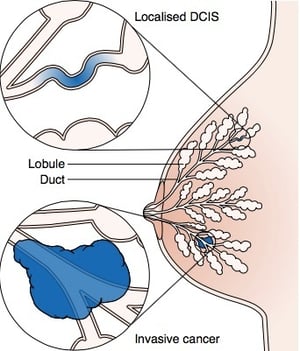 What is invasive ductal carcinoma?
What is invasive ductal carcinoma?
The most common form of breast cancer, invasive ductal carcinoma (IDC) accounts for about 80% of all breast cancers.[1] Like ductal carcinoma in situ, IDC begins in the milk ducts. Rather than remaining contained there, however, IDC spreads outside the milk ducts to infiltrate other tissues.
What are the signs of IDC?
Sometimes, the first sign of invasive ductal carcinoma appears on a screening mammogram. For this reason, regular mammography screening is the best way to ensure that IDC is caught as early as possible, when it can be most effectively treated. Other symptoms can include
- Palpable mass (lump in the breast that you can feel)
- Breast pain and/or swelling
- Thickening or dimpling of the skin on the breast
- Irritation or redness
- Painful or inverted nipple
- Unusual nipple discharge
- Lump in the underarm[2]
What is the prognosis for patients with IDC?
The reported survival rate for for patients diagnosed with IDC is constantly evolving. Although data collected in the 90s and early 2000s reflect an average five-year survival rate of around 88%, newer data (up to 2010) place that number close to 95%.[3] It’s important to understand that statistics take time to catch up with patients’ current experience, and survival rates tend to improve over time with progress in detection and treatment methods. In 2004, for example, the survival rate for IDC was reported to be 83%, and 1997, only 63%.[4] With this dramatic upward trend, patients have cause to be optimistic.
What is the treatment for IDC?
The recommended treatment (as well as the prognosis) after being diagnosed with IDC will vary among individual patients. Tumor stage is an important factor in determining the best course of action for an individual. In determining stage, doctors look at the tumor grade (how closely cells resemble normal vs. cancerous cells), size, extent, hormone receptor status, and other variables.[5] Earlier stage cancers are generally more treatable with less invasive means than later-stage cancers. Recommended treatments for IDC can range from lumpectomy and radiation to mastectomy and systemic treatments such as chemotherapy.[6]
The caring, professional staff at Iowa Radiology provides state-of-the-art imaging services for breast cancer screening, diagnosis, and follow-up. Our clinics offer low-dose 3-D mammography, breast MRI and ultrasound, and imaging-guided biopsy. For more information about breast imaging or breast cancer, access our free resources by clicking the links below.
[1] "IDC — Invasive Ductal Carcinoma." Breastcancer.org, 14 Aug 2018. Accessed 30 Aug 2018.
[3] Survival rates: "Breast Cancer Survival Rates for All Types of Breast Cancers." Moose & Doc Breast Cancer. Steven Halls, MD. 28 Aug 2018. Accessed 30 Aug 2018.
[4] "Lobular Breast Cancer: What Are the Prognosis and Survival Rates?" Healthline.com. Healthline Media, 10 Oct 2016. Accessed 28 Nov 2017.
[5] "Breast Cancer Stages." Breastcancer.org. 16 Aug 2018. Accessed 4 Sept 2018.
[6] "Treatment for IDC." Breastcancer.org. 18 Feb 2016. Accessed 4 Sept 2018.
The information contained in the Iowa Radiology website is presented as public service information only. It is not intended to be nor is it a substitute for professional medical advice.You should always seek the advice of your physician or other qualified healthcare provider if you think you may have a medical problem before starting any new treatment, or if you have any questions regarding your medical condition.
Iowa Radiology occasionally supplies links to other web sites as a service to its readers and is not in any way responsible for information provided by other organizations.






